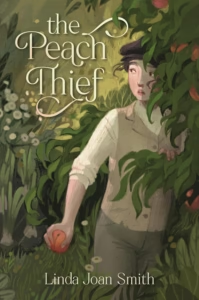The Peach Thief
Linda Joan Smith
Publisher
Published March 4, 2025
Amazon | Bookshop | Goodreads
About The Peach Thief
This shimmering middle-grade debut set in 1850s Lancashire, England, explores longing, belonging, and the courage it takes to find your place—and bloom.
The night that workhouse orphan Scilla Brown dares to climb the Earl of Havermore’s garden wall, she wants only to steal a peach—the best thing she’s ever tasted in her hard, hungry life. But when she’s caught by the earl’s head gardener and mistaken for a boy, she grabs on to something a temporary job scrubbing flowerpots. If she can just keep up her deception, she’ll have a soft bed and food beyond her wildest dreams . . . maybe even peaches.
She soon falls in with Phin, a garden apprentice who sneaks her into the steamy, fruit-filled greenhouses, calls her “Brownie,” and makes her skin prickle. At the same time, the gruff head gardener himself is teaching lowly Scilla to make things grow, and she’s cultivating hope with every seed she plants. But as the seasons unfurl, her loyalties become divided, and her secret grows harder to keep. How far will she go to have a home at last?
Beautifully crafted with classic middle-grade themes of fate and ambition, identity and personal responsibility, this stunning debut features brisk pacing, crackling dialogue, and deep insight into what makes a garden thrive—and a heart and mind flourish.
My Review
This book really got to me. From early on, I really didn’t like a certain character. It wasn’t clear to me until late in the book whether this dislike would be at odds with the story’s outcome. There’s a pretty intense scene very late in the book, and I couldn’t see how Scilla would come through it unscathed, so reading that scene was a pretty serious roller coaster ride for me. I was sweating for Scilla for sure.
I feel like the foreshadowing for the outcome of the book is really nicely done. Thinking back through the story, Scilla overlooked some things because she was so focused on keeping the secret of her identity and background. At the time, I think I was so focused on her experience that I didn’t often read the room, so to speak, and look at what was happening in the story beyond her experience.
While this is a completely different story, some elements– namely the gardening– reminded me a bit of The Secret Garden. I could see this story appealing to readers who are interested in a story like that one but perhaps want a book told in a more modern style.
All in all, The Peach Thief was a really engaging read.
Content Notes
Recommended for Ages 8 to 12.
Profanity/Crude Language Content
None.
Romance/Sexual Content/Nudity
References to kissing (off-scene). Scilla has a crush on a boy who works in the garden. Other workers burst in on Scilla just after she has showered. She turns her back to them, trying to shield her body from view.
Spiritual Content
References to characters attending church.
Violent Content
References to racist, misogynist, and classist practices, rules, and beliefs of the time. Scilla breaks into the garden in search of food and accidentally destroys a tree. Two boys dump Scilla into a barrel filled with water and manure as part of an initiation into working in the garden. A woman treats a servant cruelly after it appears she made a mistake. Allusion to child abuse (confinement in a locked chest, withholding food) in the workhouses. Scilla breaks into a greenhouse looking for something she left behind. A character charms and manipulates others, including Scilla, using a secret to coerce her. Scilla and another character steal produce from the Earl’s garden. At one point, a character purposefully destroys produce in storage.
Drug Content
Scilla smells cigar smoke from another worker.
Note: This post contains affiliate links, which do not cost you anything to use but help support this blog. I received a free copy of this book in exchange for my honest review. All opinions are my own.
